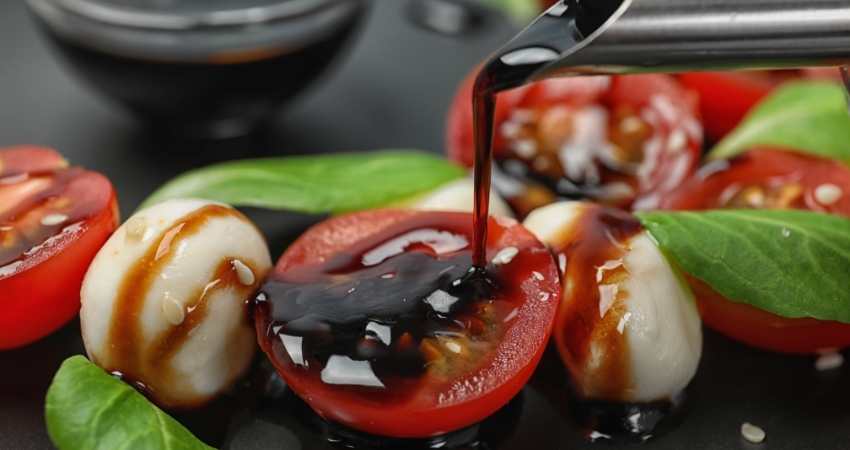Balsamic Vinegar Vs Balsamic Vinaigrette: A Comparison
Balsamic vinaigrette and balsamic vinegar are completely different yet similar enough to get confused with each other. Let’s get right to the point, are balsamic vinegar and balsamic vinaigrette the same?
Balsamic vinegar and balsamic vinaigrette are completely different from each other. While they are produced the same initially, what happens to both of them after makes them different. Balsamic vinaigrette receives more ingredients added to it than balsamic vinegar. These ingredients include olive oil, herbs and spices.
Each one of these vinegars has its own tastes and textures. I’ll inform you what they are, their differences and uses. In addition, You’ll discover how they’re different from typical salad dressing.
What Defines Balsamic Vinegar?

To compare the two, we’ll first take a look at what balsamic vinegar is. It’s made in a very similar way to wine. Typically, balsamic vinegar is made via the controlled fermentation of grapes, natural sugars, ethanol and a few other ingredients ((Aceto Balsamico: Balsamic Vinegar FAQ)). This fermentation is what gives balsamic vinegar its acidity.
Balsamic vinegar is very similar to regular vinegar except balsamic vinegar is made with grapes and then stored in oakwood barrels ((Williams Sonoma: All About Balsamic Vinegar)). All of this is what gives balsamic vinegar a very robust and strong flavor.
Disclaimer: Some of links in this article are affiliate links which means I may earn a small commission at no extra cost to you. As an Amazon associate I earn from qualifying purchases.
What Is Balsamic Vinegar Used For?
It’s important to know whether or not you’re using balsamic vinegar and balsamic vinaigrette the correct way. For each of these, we’re going to discuss what they’re used for.
Balsamic vinegar is a great way to add to the flavors already present in salads while keeping the calories low. You’ll often find in most high-end restaurants they offer olive oil with balsamic vinegar on your salad as a dressing.
It can also be used in cooking, glazing, roasting and even frying ((Wikipedia: Balsamic Vinegar)). The main purpose is just to add flavor.
A good quality vinegar can get expensive which is why I often order mine from Amazon. Check out the affordable prices they offer on a wide variety of vinegars by clicking here, balsamic vinegars.
If you’ve never had a little bit of balsamic vinegar with a touch of olive oil on your salad, give it a try. You’d be doing yourself a huge favor to try it out. It’s amazing how two simple ingredients can genuinely transform a bland and boring salad into something spectacular. In addition, it’s healthier than traditional salad dressing.
Do you store your balsamic vinegar in the cabinet or the fridge? For the correct answer, you may want to check out my blog post on the topic by clicking here, Should You Refrigerate Balsamic Vinegar?
What Defines Balsamic Vinaigrette?
Balsamic vinaigrette starts off by being made in exactly the same way that your traditional balsamic vinegar is made. In case you skipped over to this section, it’s made via the controlled fermentation of grapes, ethanol, sugars and more.
What sets balsamic vinaigrette apart from traditional balsamic vinegar is it’s a bit more enhanced and altered. Therefore, the balsamic vinaigrette could contain herbs, spices and certain flavors you won’t find in traditional balsamic vinegar1.
An example of this would be: Lemon flavored balsamic vinaigrette, garlic and a few other well-known flavors2.
When we’re discussing balsamic vinegar, I’ve mentioned when adding it to a salad dressing, some restaurants like to offer you olive oil. Balsamic vinaigrette already contains some form of oil. This is either olive oil or sunflower oil but mostly, olive oil.
This is why it’s important to shake balsamic vinaigrette before using it. If you don’t do this, you won’t benefit from the other oils. It only takes a few minutes for the oil to separate from the vinegar. Therefore, it requires you to shake it, so it mixes together again.

What Is Balsamic Vinaigrette Used For?
Balsamic vinaigrette is used the same way balsamic vinegar is used. You can use it in salads and in your cooking. There’s one other thing that balsamic vinaigrette is really good for. Let’s take a look.
Balsamic vinaigrette is a great way to marinate your meat like steak, chops and chicken. This is because of the oil in the vinaigrette. It’s often a lot thicker and more likely to stick to the meat than balsamic vinegar. When you add in the included spices, you get with vinaigrette, marinating meat has never been easier.
Is Balsamic Vinaigrette Just Oil And Vinegar?
Balsamic vinaigrette is not just simply oil and vinegar mixed together. Typically, it doesn’t contain any herbs, spices or strong flavors. Balsamic vinaigrette is its own standalone product and it’s much different from the traditional balsamic vinegar.
There are different types for different situations. Therefore, you might have one containing certain ingredients designed to enhance your salads.
Then you might have another type of balsamic vinaigrette more aimed at helping you marinate steaks and other types of meat. Finally, you might get a vinaigrette supposed to be used more as a source and drizzled over cooked food.
It’s best used as a preservative for pickling. In a few rare situations, it makes a great condiment. As a condiment, it’s typically used on fries and/or salads.
If you have any questions to ask me about this article don’t hesitate to comment below or email us. You can find an email on our contact page.
Read Next – More Food vs Food!
Farm Raised Salmon Compared To Wild Caught Salmon
Organic Broccoli – Here’s What You NEED To Know
Extra Virgin Oil Vs. Olive Oil: A Comparison
- EWG: Good & Gather Organic Balsamic Vinaigrette, Balsamic [↩]
- Wikipedia: Vinaigrette [↩]
